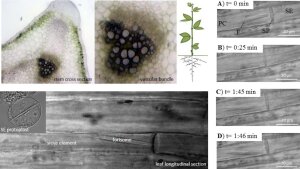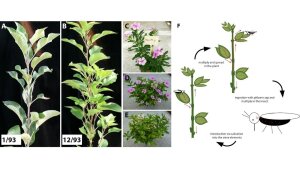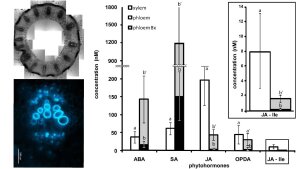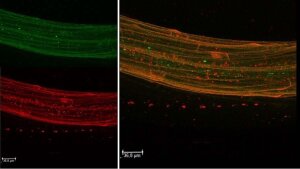Research Topics
1. The role of sieve-element occlusion proteins in root pathogenesis and phloem signalling (DFG project)
After IP (invasion pattern) application to Arabidopsis thaliana roots the first and most rapid reaction is the transmission of an electrical signal along the plasma membrane of phloem cells. The membrane depolarization leads to a Ca2+ increase in sieve elements, resulting in filament formation of P-proteins and, later on, callose deposition at sieve plates and pore plasmodesma units (PPUs). This topic will be investigated by Dr. Matthias R Zimmermann in cooperation with Prof. Dr. Dirk Prüfer (Fraunhofer Aachen) and Dr. Gundula Noll (Uni Münster).
2. The impact of phytoplasma infection on phloem function
Phytoplasmas are prokaryotic plant pathogens of the class Mollicutes, inhabit almost exclusively the phloem sieve elements and are transferred by insect vectors. Phytoplasma infection severely impairs photoassimilate translocation in plants and might be responsible for changes in phloem physiology. Infections brings about Ca2+ influx into sieve elements, changes in phytohormone distribution and sieve element occlusion (Pagliari et al., 2017). This topic will be investigated by Dr. George Ochieng Asudi (Humboldt Fellowship, Kenja) using Napier grass. In cooperation with Prof. Dr. Michael Kube (University Hohenheim), PD Dr. Jürgen Gross (Julius Kühn Institute Dossenheim) and Prof. Rita Musetti (University Udine, Italy) I will investigate phloem impairment in response to phytoplasma infection in Alnus glutinosa trees, fruit trees and Arabidopsis plants.
3. Vascular exudation process
The typical response of cucurbit plants to mechanical wounding is an immediate occurrence of several, rapidly increasing, single droplets at wound surfaces that merge to one single drop and cover the entire wound surface area at the end. The wound-induced exudation reflects the first, rapid defence response to mechanical damage of plant tissue with an orchestrated loss of vascular content for plant health and tissue integrity. We will analyse quantitatively diverse parameter influencing the exudation process respectively exudates volume and allows deeper insights into the exudation physiology and the cooperation of phloem and xylem during the exudation process (Dr. Matthias Zimmermann).
4. The interaction of xylem- and phloem-compounds during pathogen attack
The lateral exchange of phytohormones between xylem and phloem after treatment with pathogens like Pseudomonas syringae, Golovinomyces orontii and Turnip Crincle Virus and with the beneficial fungus Piriformospora indica shall illustrate a collaboration during short- and long-distance signalling. (In cooperation with PD Dr. Axel Mithöfer; MPI, Jena).
5. Mechanisms for maintaining the diversity of host races in the pea aphid
There are more species of herbivorous insects on our planet than almost any other group of animals outside of microbes. To explain this enormous proliferation of species, we are studying how insect herbivore species diversify by host plant shifting using the pea aphid (Acyrthosiphon pisum) as our model. PhD student Maria Paulmann will explore potential plant-aphid interactions, will measure the phloem mass flow, forisome configuration, hormone levels and defense metabolites and genes in selected combinations of pea aphid host races and legume host plants.
Supervisors: Grit Kunert and Jonathan Gershenzon (Department of Biochemistry, MPICE); Alexandra CU Furch and Ralf Oelmüller (Friedrich-Schiller-University, Jena).
6. Mechanisms of rhizobia tolerance to aluminium stress
Phaseolus vulgaris is a common source of proteins for most Kenyans. However, in the recent years, its production has been very low due to poor soil fertility. Inorganic fertilizers are expensive and out of reach of poor farmers. Inoculation of Phaseolus vulgaris with effective Rhizobia which convert free atmospheric N2 to NH4+ utilizable by plants is a better alternative. Rhizobia can infect legume roots and convert free N2 into NH4+ which is utilizable by plants. Flavonoids induces expression of nod gene through the activation of NodD proteins. Enzymes encoded by the nod genes lead to the synthesis of Nod factors that are recognized by host Nod factor receptors. However, their growth, proliferation and symbiotic potential are restricted by high aluminium toxicity in these soils. PhD student Clabe Wekesa (DAAD) will determine mechanisms in which indigenous rhizobia are able to tolerate alum toxicity so that this mechanism may be transferred to effective but susceptible rhizobia for inoculation in Western Kenya soils.



